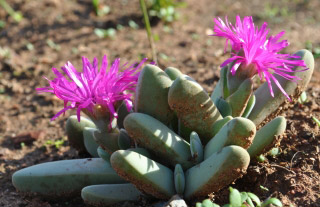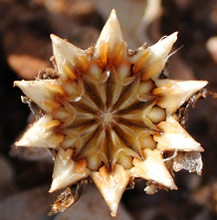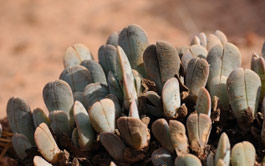Cheiridopsis purpurea
Cheiridopsis purpurea L.Bolus
Family: Aizoaceae
Common names: cheiridopsis
Introduction
Cheiridopsis purpurea is a small succulent endemic to the Richtersveld in the Northern Cape, with brilliant, intense, magenta-pink flowers.

Description
Description
Cheiridopsis purpurea is a small clump-forming succulent that produces leaves in pairs, with one or two (sometimes three in cultivation) pairs per branch. The leaves are joined together when young, and separate as they mature. They are triangular and keeled, sometimes with teeth along the keel, 30-50 mm long, with a typical blue-green colour and with transparent dots. The old leaves persist to form corky brown sheaths that protect the new growth. The solitary, showy purplish pink flowers are up to 40 mm across and appear from June to August. They open around midday and close at sunset. The broad petals are different from those of other Cheiridopsis species as they do not unfold fully but hide the stamens and feathery stigmas. Only after a few days the inner petals will also open. The 10-locular capsules have awn-like points at the tips of expanding keels.

Cheiridopsis purpurea falls under the subgenus Aequifoliae which indicates that in adult plants the leaf pairs look more or less the same.
Conservation Status
Status
The current conservation status of Cheiridopsis purpurea is listed as Rare (Raimondo et al. 2009) due to the small restricted area and the habitat specialist nature of the plant.
Distribution and habitat
Distribution description
Cheiridopsis purpurea is endemic to the Richtersveld, growing on the Karrachabberg and surrounding mountains in the Northern Cape. It grows in the crevices of quartzitic bands in sandstone in Succulent Karoo vegetation.
Derivation of name and historical aspects
History
Cheiridopsis purpurea was first described in 1931 by Harriet Margaret Louisa Bolus. The genus name Cheiridopsis is derived from the Greek word meaning sheath, referring to the thin white papery leaf sheaths that are formed during the dormant period. This is not a distinguishing characteristic, as only a third of the species of Cheiridopsis form leaf sheaths, and they may not form in cultivated specimens. Previously about 100 Cheiridopsis species were recognised, but researchers of the Hamburg University reduced them to 23 species, with 9 more identified since then. Another species found in Namaqualand, including the Richtersveld, is the t'noutsiama, Cheiridopsis denticulata, which creates an awesome display when in full flower in spring at the Karoo Desert National Botanical Garden.
Ecology
Ecology
Cheiridopsis purpurea is pollinated by insects. The woody capsules are hygrochastic (opening when wet) and the tiny seeds are splashed out of the capsule by the heavy raindrops. The capsules are constructed so that only some of the seeds are released at a time to ensure that seeds are available later when conditions may be more favourable for germination. Vygies are short-lived, usually less than 10 years, and need this complex capsule to ensure survival.

Uses
Use
The only use recorded for this plant is for the horticultural trade.

Growing Cheiridopsis purpurea
Grow
Cheiridopsis purpurea occurs in the winter rainfall region with hot, dry summers. It does best when grown in similar conditions or in a greenhouse, as the plants need to go dormant in summer. C. purpurea needs a sandy, well-drained soil that is rich in minerals. This succulent needs little water but responds well to regular water in autumn to winter. Water should be withheld in summer, but plants can be sprayed with a fine mist from time to time.
Cheiridopsis purpurea can easily be grown from seeds. Sow seeds in the autumn months. To improve the chances of germination, place the seeds in a small container with warm water and leave for 24 hours. This will soften the hard outer layer of the seeds. Sow the seeds in a sandy medium and cover with a thin layer of fine sand about 1 mm thick. Keep it damp, using a fine spray, until seeds start to germinate in about seven to fourteen days. Once the seedlings start growing, slowly reduce the amount of water.
References
- Barkhuizen, B.P. 1978. Succulents of Southern Africa. Purnell, Cape Town.
- Hartmann, H.E.K. 2001. Illustrated handbook of succulent plants: dicotyledons. Springer-Verlag, Berlin, Heidelberg.
- Hartmann, H.E.K. 1998. Growth forms and leaves in the genus Cheiridopsis N. E. Br. [run on] Cactus & Succulent Journal (U.S.) 60: 168-173.
- Jackson,W.P.U. 1990. Origin and meanings of names of South African plant genera. University of CapeTown, Rondebosch.
- Raimondo, D., Von Staden, L., Foden, W., Victor, J.E., Helme, N.A., Turner, R.C., Kamundi, D.A. & Manyama, P.A. (eds) 2009. Red List of South African plants 2009.
- Schwantes. G. 1957. Flowering stones and mid-day flowers. Ernest Benn, London.
- Smith, G.F., Chesselet, P., Van Jaarsveld, E.J., Hartmann, H., Hammer, S., Van Wyk, B-E., Burgoyne, P., Klak, C., Kurzweil, H. 1998. Mesembs of the world. Briza, Pretoria.
- Strelitzia 25.South African National Biodiversity Institute, Pretoria.
- Williamson, G. 2000. Richtersveld - The enchanted wilderness. Umdaus Press, Hatfield, Pretoria.
Credits
Lize Wolfaardt
Karoo Desert National Botanical Garden
March 2012
Plant Attributes:
Plant Type: Succulent
SA Distribution: Northern Cape
Soil type: Sandy
Flowering season: Winter
PH: Neutral
Flower colour: Purple, Pink
Aspect: Full Sun
Gardening skill:
Special Features:
Horticultural zones







Rate this article
Article well written and informative
Rate this plant
Is this an interesting plant?
Login to add your Comment
Back to topNot registered yet? Click here to register.